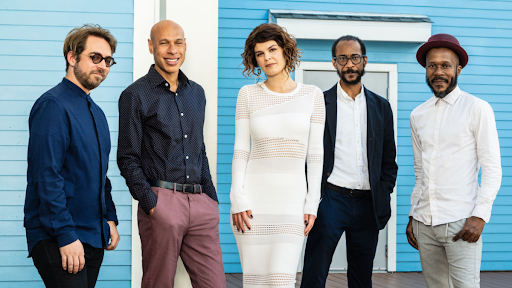by Kevin McLaughlin

Recently, with the addition of Gabrielle Cavassa, he has broadened his expressive palette to include the human voice. Cavassa joined the Joshua Redman Group at the Cleveland Museum of Art’s Gartner Auditorium for a superb display of talent on Wednesday, January 10. And though Redman’s expressive and technically astounding tenor sax dominated the evening, what lingered in the heart were Cavassa’s superb interpretations of the songs.
Part travelogue and part social commentary, the program drew largely from Redman’s newest album, where are we, his first with Blue Note records. In the liner notes, Redman explains, “On one level, this is an album ‘about’ America — at once a celebration and a critique.”
For Chicago Blues, Redman mashed up Sufjan Stevens’ Chicago and the classic blues tune Goin’ to Chicago. Static chord loops from Redman and pianist Paul Cornish created a luminous haze of sound, preparing Cavassa’s first entrance, and surprising an audience expecting harder-edged stuff. In fact, the pleasure of sound for its own sake was a regular companion on this musical expedition.
There is something both traditional and progressive about Cavassa’s singing. Jazz is a tradition-laden art form in any medium, but the modern-day jazz singer strikes a special bargain with history and influence since both reveal themselves so readily. I heard in Cavassa’s voice Blossom Dearie and Norah Jones — perhaps with hints of Billie Holiday. But she has an unconventional relationship to words, often abandoning diction to create instrument-like expression with her voice. At several points she matched Redman’s saxophone sound so closely it was hard to tell them apart. Sometimes you didn’t understand the words, but you always got their meaning.
Bruce Springsteen’s Streets of Philadelphia managed to be as complete a portrayal of urban despondency as the original, here deepened by a jazz accent. Cavassa again sang with a soulfulness that was beyond her years.
Redman edged into pop with some unexpected arrangements of The Eagles’ Hotel California — a selection not included on the album— and Jimmy Webb’s By the Time I Get to Phoenix. Both made for convincing jazz reinterpretations. Redman prefaced the latter with an extended sax monologue, sometimes alternating high and low lines in duet with himself. I thought I heard a quote from Sonny Rollins’ St. Thomas at the end — maybe a bonus destination on our tour. Nazir Ebo’s snare drum accompaniment was an inventive counter to the voice-sax duo.
The time constraints of concerts at Gartner Auditorium (performers need to be finished by 9 pm so the museum can be cleared of patrons) prevented every piece on the album from being played, but those represented on Wednesday were enough to project its COVID-inspired themes of the joy of gathering and the pain of separation.
Rhode Island is Famous for You, a song naming as many states as there were in 1948, was a cute and thematically apt number. Written by Arthur Schwarz and Howard Dietz for a Broadway musical revue titled Inside USA, it was recorded most famously by Blossom Dearie — channeled here with whimsical and endearing delivery by Cavassa.
That’s New England, a favorite of vocalist Betty Carter’s, was a chance for bassist Philip Norris to show off his considerable chops in an extended unaccompanied cadenza. The solo was a tour de force of technique and pacing, summoning the ghost of Slam Stewart, known for singing in unison to his own improvised melodies.
In introducing After Minneapolis, Redman’s musical reaction to the murder of George Floyd, the saxophonist reminded listeners that “the promise of the American Dream is not available to everyone.” Redman’s unaccompanied intro, emotional and raw, set the tone for Cavassa’s heartfelt rendering of the lyrics, and Cornish and Norris contributed deftly to the rhythmic shifts and harmonic flow. Redman concluded with one more breathy solo and a final ‘ffft’ pointing toward some ethereal realm.
You and the Night and the Music, another great tune by Schwartz and Dietz, saw the ensemble climb to further virtuosic heights. Ebo stretched out with an extended introductory cadenza, mostly on low drums, before whirlwind improvisations by Redman and Cornish. Cavassa sang a final sultry chorus before Redman bid goodnight to the exhilarated throng. How could the journey be over so soon?
Published on ClevelandClassical.com January 16, 2024.
Click here for a printable copy of this article



